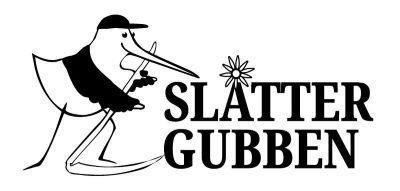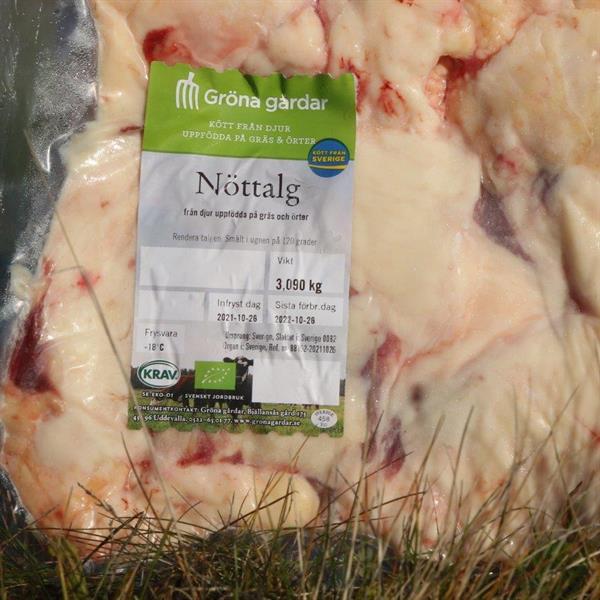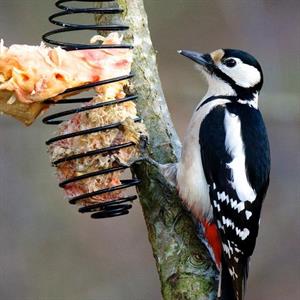Tallow from cattle 3kg
The best food for tits and woodpeckers!
- In stock
Description
Sallow is the birds' best raw food!
It contains nearly 100% untreated organic fat. A little meat and some glands are often included in the suet. This is the absolute healthiest fat product for tits and woodpeckers. Jays, magpies, and jackdaws also love suet, of course!
Storage:
Store in the freezer. Hang out the tallow when the temperatures are predominantly below freezing. Fresh suet will go rancid if it's too warm.
Delivery:
Delivered frozen. During shipping, the suet may thaw slightly. If so, pack it into suitable portion bags and freeze it again while it's thawed.
How do I feed with suet?
Since these pieces of suet are quite small, it’s best to put them in a grilling net. It has an easy closure, and you can then simply hang it up.
You can also slowly melt the tallow in a pot. It’s best to chop it into even smaller pieces to speed up the melting process. Alternatively, you can run the tallow through a meat grinder before melting it. Or “render” it, as it’s called in the more refined terms.
It takes a little time for the tallow to melt, but eventually, you’ll be left with small pieces floating around in the melted fat. You can let it solidify a little, add seeds to the mixture if you want, and then let it fully harden in the desired shapes, depending on how you want to feed the birds. Melted tallow holds up very well at refrigerator temperature (for many months) and even for a long time at room temperature. The remaining bits of tallow that float around in the fat can be left in, as birds really enjoy them. If you’re melting tallow for human consumption, it’s good to fish them out a little before they start to taste burnt. They are, after all, very good food!
Our suet comes from KRAV-certified cattle from Gröna Gårdar, which help keep nature pasturelands open – this is important for many birds, insects, flowers, and more.
It’s wonderful to be able to offer a fat product that indirectly benefits many of the birds that migrate to warmer countries in the winter, like the cuckoo, red-backed shrike, wheatear, barn swallow, curlew, and starling.
Cheap suet balls can contain as little as 14% fat from unknown sources. Often, this fat is palm oil from cut-down rainforests or tallow from confined cows that have eaten soybeans from Brazil’s former rainforests and savannas.
BirdLife Sweden’s flagship species is the Pygmy Falcon – a species living in Southeast Asia’s rainforests, which are rapidly being cleared for palm oil plantations. The Pygmy Falcon doesn’t realize that it’s catastrophic for its population when the suet balls contain palm oil.
The suet has a transportation emission equivalent to 0.14 kWh/kg (0.038 kg CO2 equivalent/kg) from breeding to our warehouse.
Read more about these calculations [here].
KRAV-certified
---
Can the tallow be used as human food?
Formally, we only sell it as animal feed and disclaim responsibility for its use as human food. However, it’s exactly the same tallow that Gröna Gårdar packs and sells as human food. It comes to us pre-packaged and frozen from Gröna Gårdar and is resold in the same packaging, frozen.
I (Slåttergubben) am a steadfast advocate for using tallow as food. Partly because it’s healthy. This organic tallow from grass-fed animals is especially beneficial due to its rich content of good omega fats. Also, no other fat has a positive impact on biodiversity. Fat from pigs comes from confined animals that don’t graze. Oil-based fats come from intensive farming – yes, they can be organic, but we are severely lacking grazing lands in Sweden, which we need to support.
Moreover, I genuinely enjoy tallow, and it’s a byproduct that would otherwise have been thrown away or sent to industrial processes where it would become cosmetics, suet balls, dog food, candles, or a raw material for the chemical industry.
I use tallow in three ways:
1. Slice/chop into small pieces and add to stews, pea soup instead of pork, cabbage soup, etc. It’s incredibly filling and tasty! It can completely replace cured pork in pea soup.
2. Slice/chop into small pieces and fry, often with some vegetables, like root celery and onions. This is actually my regular breakfast!
3. Melt according to the method described above and use as cooking fat, frying oil, or fat in food preparation, sometimes even on bread.







